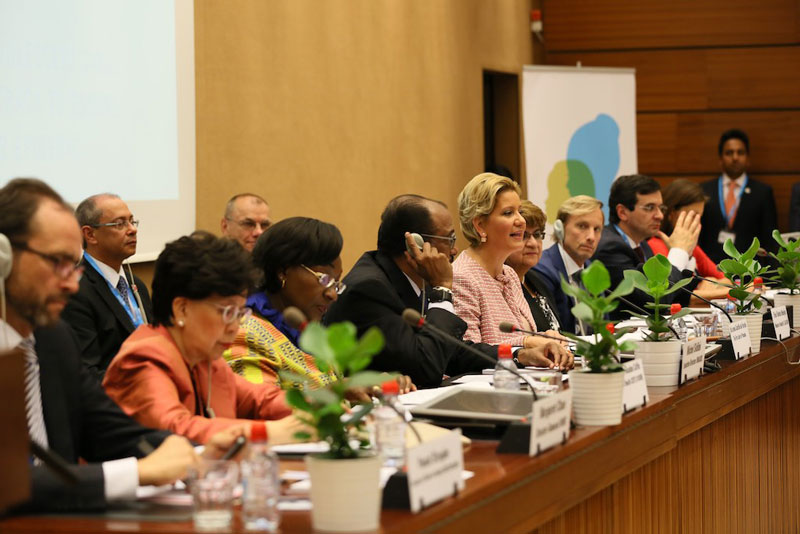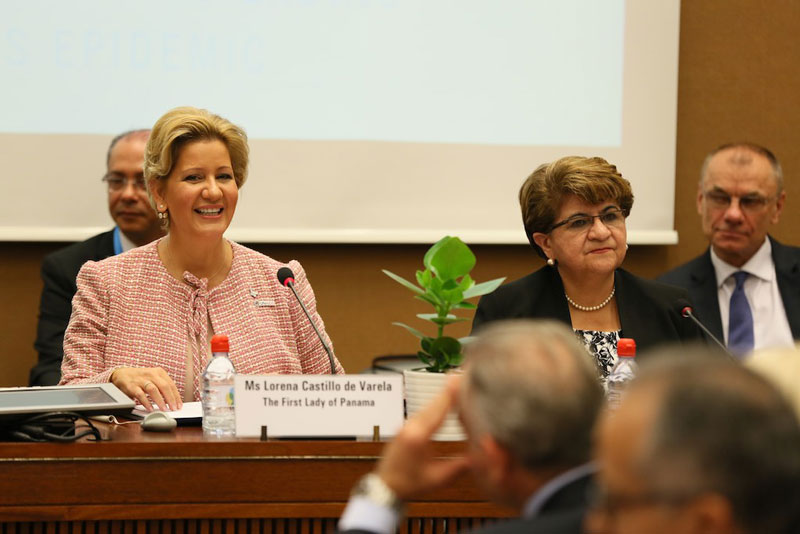Geneva, 23 May 2016 (PAHO/WHO) - Delegates from several countries of the Americas and other nations attending a side event to the 69th World Health Assembly agreed that giving women and adolescent girls access to health services—including prevention, treatment, and drugs to prevent mother-to-child transmission—will be key to ending the HIV epidemic by 2030.
The high-level meeting "Women and adolescent girls on the Fast-Track to ending the AIDS epidemic" was organized by the First Lady of Panama and UNAIDS special ambassador for AIDS in Latin America, Lorena Castillo de Varela.



Globally, in 2014 there were 17.4 million women over 15 years of age living with HIV and 870,000 infected with the virus. Females accounted for 62% of new infections in adolescents, and 420,000 women died from HIV-related causes that year. The Sub-Saharan region of Africa was the most affected.
"In order to reduce new infections and deaths related to HIV, we must enhance gender equity and empower women to make their own health decisions," said Castillo de Varela, who called for involving women and adolescents "in the design and implementation of essential programs to meet their health needs."
Panama's Minister of Health, Javier Terrientes, pointed out that "women are crucial for putting an end to the HIV epidemic" and mentioned the actions taken by his country to move in that direction, in alignment with World Health Organization (WHO) and UNAIDS strategies. "For more than 15 years, Panama has offered drugs that treat the infection free of charge, and 90% of pregnant women are tested for HIV," he said, adding that "prevention and early treatment are fundamental pillars for ending the epidemic."
"There are 1.8 billion adolescents and young adults in the world. If we do not address them, we are not going to be able to achieve our goal of ending the HIV epidemic by 2030," said WHO Director-General Margaret Chan. "Women and girls should have opportunities to reach their full potential. We must fight discrimination and violence against women and young women, and work with men in order to do so."
Flavia Bustreo, WHO Assistant Director-General of Family, Women's and Children's Health, said that in many countries, females of all ages are at greater risk of HIV infection and suffer the greatest burden of the epidemic. "HIV continues to be the second leading cause of death of adolescents in the world," she said, stressing that prevention and treatment should be incorporated throughout a person's life course, taking an approach that begins with an infant born free of the infection. "We can halt the epidemic by adopting a comprehensive approach for women and young people that also includes their partners, by linking HIV prevention with reproductive health," she stated.
For Michel Sidibé, UNAIDS Executive Director, "addressing women's health and HIV is a matter of human rights, gender equality, and social justice."
Sidibé mentioned that in 2000, barely 1% of pregnant women in the world received life-saving HIV treatments. By 2010, that percentage had risen to 73%. Furthermore, the number of new HIV infections in children has fallen nearly 60% since 2000. "With political will, mother-to-child transmission can be prevented. Cuba is an excellent example of eliminating this problem," he said, adding that we must "step up the pace and make sure that all women and children are included, with no one left behind."
In addition to Panama, other countries sponsoring the meeting were Canada, Ecuador, El Salvador, the Dominican Republic, and the United States, along with Australia, Côte d'Ivoire, Portugal, South Africa, Switzerland, and Zambia, with support from the Global Fund to Fight AIDS, Tuberculosis, and Malaria, the WHO Secretariat, and UNAIDS.
The Regional situation
An estimated 1.7 million people in Latin America, including 33,000 children, were living with HIV in 2014 and women 15 years or older accounted for 31% of all infected persons. The estimated number of new infections has remained at 87,000 since 2011. Stigma, discrimination, and violence are significant barriers to the provision and use of prevention and treatment services in the region.
Violeta Menjívar, Minister of Health of El Salvador, reported that her country is reducing the number of new HIV cases and associated mortality, as well as mother-to-child transmission, through a combined strategy of cross-sectoral efforts. However, she recognized that cultural inequality and inequity patterns prevail in El Salvador and several other countries in the Americas, which adversely affects the situation of women, girls, and adolescents with respect to HIV.
"One out of five women with HIV in El Salvador is a housewife," she explained, adding that because of cultural issues, these women "cannot negotiate the use of condoms with their partners." Menjívar said that her country provides universal access to free antiretroviral therapy, that the Salvadorian Congress is discussing a new law on a comprehensive response to HIV, and that 77% of the response to the epidemic is publicly funded, ensuring sustainability.
Brazil's Minister of Health, Ricardo Barros, pointed out that in his country the epidemic is concentrated in key population groups (such as transsexuals and men who have sex with men), but recognized the need to give higher priority to women and girls, since "gender issues continue to be determining factors in the HIV epidemic." Barros went on to say that his country is one of the biggest buyers of female condoms in the world. "Last year 22 million of these condoms were distributed free of charge," he said.
Pamela Hamamoto, Permanent Representative of the United States of America to the United Nations, called for "surrounding women with health services throughout their lives" to improve their health and prevent HIV. She said that the United States President's Emergency Plan for AIDS Relief (PERFAR) is committed to reducing HIV in the 10 most affected countries of Africa. To this end, she said, they are bringing education to the schools, because "investing in education for girls is essential in order for them to live the life they deserve and break the cycle of poverty and violence."